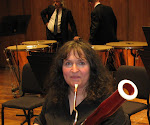The Marriage of Figaro is certainly one of the greatest operas ever written and as all bassoonists know, Mozart was a true master of bassoon writing. The opera contains gorgeous lyrical solos as well as some daunting, nearly unplayable technical passages, as a great example of a challenge beyond what we usually see in orchestral lit.
Judging from the cheering and uproarious laughter of the audience (it is an opera buffa after all) during our performances, I'd say it was a huge success. I found myself thanking my lucky stars that I taught myself to double tongue early in my career, because I would not have come close to pulling off Mozart's bassoon expectations without a reliable double tongue.
One of the most common excerpts for orchestral auditions is the Overture to The Marriage of Figaro, and it includes long successions of double tongued Ds and As. Many bassoonists learn to double tongue (the double-tongued notes are circled in red below) just so that they can play this excerpt up to tempo (which is around 144 bpm or faster):
 | ||||||||
At the end of Act IV (the end of the opera) there is a lengthy succession of very fast tongued notes played with the celli and basses. It's very exposed in the small orchestra we're using in the pit this week. This is the part:
And this is what it sounds like in measures 487- 495 from the above page:
For this passage, assuming the player can double tongue at the given tempo, if any inaccuracy is detected, I advise playing the passage all slurred several times (with precision!) to ensure that the fingers are moving correctly. Once the fingers are moving with reliable accuracy, then add the double tonguing. 9 times out of 10, that fixes any problems.
There's no doubt in my mind that double tonguing on the bassoon is absolutely essential for not only the Overture of the Marriage of Figaro, but for the ends of Acts II and IV as well.
When I was a student of K. David Van Hoesen at the Eastman School of Music, double tonguing was not taught to bassoon students at Eastman. Mr. Van Hoesen knew how to double tongue, but for some reason he chose not to teach it to his students. My best guess is that he thought we all had bigger fish to fry. 😂
Once I started my job in the Columbus Symphony, it didn't take long for me to realize that double tonguing was more than just a parlor trick-- it's actually a necessity. I think it was the 4th movement of Mozart's Haffner Symphony which brought me to that realization, or maybe it was the Smetana Overture to the Bartered Bride. I had a fast single tongue, so I was able to get by in most situations, but I decided I'd have to teach myself to double tongue if I wanted to be able to play every note in my parts as written. If you're a bassoonist who doesn't yet double tongue, learning it will be time and effort well spent. Double tonguing on the bassoon has become mainstream!







